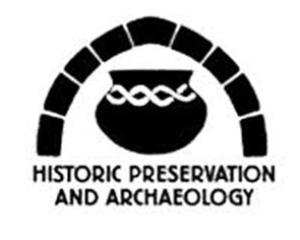
September will be the 27th annual celebration of archaeology in our state and the return of our printed commemorative posters.The 2022 poster design focuses on late Pre-contact pottery styles. The ceramics of the Late Pre-contact period of Indiana indicate that Native American groups were not static but were diverse, dynamic, and complex. We celebrate the diversity present in these unique artifacts.

Oliver Mansion, West Washington Street Historic District, South Bend
If you would like a poster, stop by the DHPA office at 402 W. Washington Street, Room W274 in Indianapolis. You can also visit DHPA archaeologists at one of our Archaeology Month events, where we will have posters and other handouts (including printed copies of Early Peoples of Indiana), or you may contact our office to request a poster.
For more information on Archaeology Month, visit our website. We hope you will be able to attend some of the events, and we encourage you to follow our office and DNR on Facebook, where we will post more information about archaeology in Indiana and our theme for 2022.
We look forward to celebrating with you!

Cisterns—Water, Water, Everywhere!
Water is an essential part of life. The human body is made up of about 60% of water. Domestically, it is crucial for drinking, cooking, cleaning, bathing, and watering gardens. Industrially, water is used for cleaning, cooling machinery, diluting solvents, making paper, pumping oil, and generating power, just to mention a few.
Water is also used to put out fires. Obtaining and storing water to satisfy our needs is an important part of our society. Before modern plumbing, cisterns were a common way to collect and store water for later use; however, not all cisterns were made the same. Human ingenuity can be seen archaeologically in how cisterns were constructed. Read more about cisterns.

Indiana State Library Display

The DHPA invites you to visit our two display cases at the Indiana State Library in Indianapolis. The exhibits are in honor of Indiana Archaeology Month and will be on display until late October. One case represents our Archaeology Month theme of Pre-contact Ceramics, and the other will offer a glimpse of the types of artifacts found in Indiana.
The cases are on the second floor in the Grand Hall (on the east side of the building). Archaeology team member and research archaeologist Rachel Sharkey put together this exhibit.
The image shows one of the cases from the 2021 display.
A Popular Tiny Toy

Toys provide insights into the lives of children and can be some of the most poignant and interesting items found at archaeological sites. Just as they do today, toys in the past varied in size, and a diminutive form of doll made during the period of roughly 1850-1920 was very popular.
Produced originally in Germany, these affordable, molded porcelain dolls had rigid arms and legs and came in sizes generally ranging from 1 to 18 inches tall. In the 19th century the smaller of these were known as “penny” dolls because of their price. Regardless of social class, children in many American homes could have had access to these toys given their inexpensive cost and wide availability during the Victorian and early Edwardian periods. Read more about these toys.
Historic Preservation Fund (HPF) Grant Round for 2023

Application packets are currently available on the DHPA website for the Fiscal Year 2023 HPF Matching Grant Program. This program assists certain types of local preservation projects conducted by municipal and county governments, not-for-profit organizations, and colleges and universities.This year’s grant application deadline is Friday, Oct. 7 at 5 p.m. Projects selected for funding can start around June 1, 2023 and must be completed within 24 months. Read more about the HPF grants.
Historic Preservation Fund Archaeology Grants

As described by the National Park Service, “… the Historic Preservation Fund (HPF) is the funding source of the preservation awards to the States, Tribes, local governments, and non-profits … and the funding is provided by Outer Continental Shelf oil lease revenues, not tax dollars. The HPF uses revenues of a nonrenewable resource to benefit the preservation of other irreplaceable resources.”
Each year, the Division of Historic Preservation & Archaeology (DHPA) receives funding under the HPF program administered by the U.S. Department of the Interior, National Park Service. The HPF program promotes historic preservation and archaeology in Indiana and benefits the State in meeting its goals for cultural resource management. Read more about HPF archaeology grants.

Recent Listings on the National Register
Between May and June 2022, Indiana added nine listings to the National Register of Historic Places. These listings—houses, a barn, a residential and commercial district, a bridge, a depot, a student center, and a parish district—have added approximately 103 historic resources to the National and State registers. For information on Indiana properties listed in the National Register of Historic Places and the Indiana Register of Historic Sites and Structures, go to https://secure.in.gov/apps/dnr/shaard/welcome.html. Read about those recently listed here.
Preserving Historic Places: Indiana’s Statewide Historic Preservation Conference

WHAT: Preserving Historic Places: Indiana’s Statewide Historic Preservation Conference
WHEN: Sept. 27-30, 2022
WHERE: Various sites in South Bend
INFO: indianalandmarks.org/preserving-historic-places-conference
WHO: Indiana Landmarks, the Indiana Division of Historic Preservation & Archaeology, and Indiana University host the annual Preserving Historic Places Conference, with support from the National Park Service, Saint Joseph County Council, and the City of South Bend.
Read more about the conference activities and how to register here.
Headstone Collection

The DNR Division of Historic Preservation & Archaeology (DHPA) maintains the Indiana Cemetery and Burial Ground Registry under Indiana law IC 14-21-1-13.5. This program, started in 2001, aims at locating and documenting every cemetery and burial ground in the state.
Due to the vast amount of information, the cemetery registry was included as part of DHPA’s searchable SHAARD database. Cemetery information can also be accessed through the Indiana Historic Buildings, Bridges and Cemeteries (IHBBC) map.
Because there are about 20,000 cemeteries and burial grounds in Indiana, it is not possible at this time to document each grave marker, inscription, and name. Recently the Indiana Geological and Water Survey (IGWS) published information in E-GeoNews on its program documenting headstones from 189 cemeteries in Indiana.
The information is housed in the IGWS digital assessment management system, ResourceSpace. This is a wonderful resource for headstone research and whetstone markers in particular.
Listen to and Reading about History, Archaeology, and Historic Preservation
The DHPA staff loves podcasts, social media, and resources related to history, archaeology, and historic preservation. So, we thought we’d share our favorite finds. In each newsletter issue, we’ll highlight something we’ve found or use.
The Preservation Technology Podcast is brought to you by the National Park Service and the National Center for Preservation Technology and Training. The series is “about the people and projects that are bringing innovation to preservation” and cover topics from technical advice, disaster planning, job hunting tips, cemeteries, international preservation, documenting disappearing resources, museum studies, oral history, cultural landscapes, and advocating and interpreting underrepresented communities.
There are currently more than 100 podcast episodes, most averaging between 10 and 20 minutes. You can download episodes from the website (ncptt.nps.gov/articles/podcast/) or subscribe via iTunes/Apple Podcasts. If you aren’t a podcast person, transcripts are also available online.
Are you on Instagram? Malia Vanaman, DHPA Grant Manager, recommends the following: @restoringyourhistorichouse (if before-and-after pictures make you giddy, this one is for you!) and @historichousedogs (because combining adorable pups and cool historic houses is just brilliant).
What archaeology, architecture, or preservation pages do you follow? We want to know at DHPAConnect@dnr.IN.gov!
Follow DHPA on Facebook
The Division of Historic Preservation & Archaeology is on Facebook. Follow us at www.facebook.com/INdhpa to find out about upcoming events, participate in trivia, find out about things to see and do throughout the state, and learn interesting facts about preservation in Indiana. If you have suggestions for topics or questions for future discussions let us know at dhpaconnect@dnr.IN.gov.
DHPA Staff Programs
Staff from the DHPA offer free programs around the state on a variety of topics, including archaeology, Underground Railroad, cemeteries, and preservation. If you would like to learn more about these topics, check out the Calendar of Events and find the talk closest to you. Or, if your organization is looking for a speaker, contact the DHPA for potential speakers and topics.
Tell us what you think!
We are always interested in your ideas. If there is a topic you would like to see in an upcoming issue of Preservation at the Crossroad, send us an email at dhpaconnect@dnr.IN.gov.
